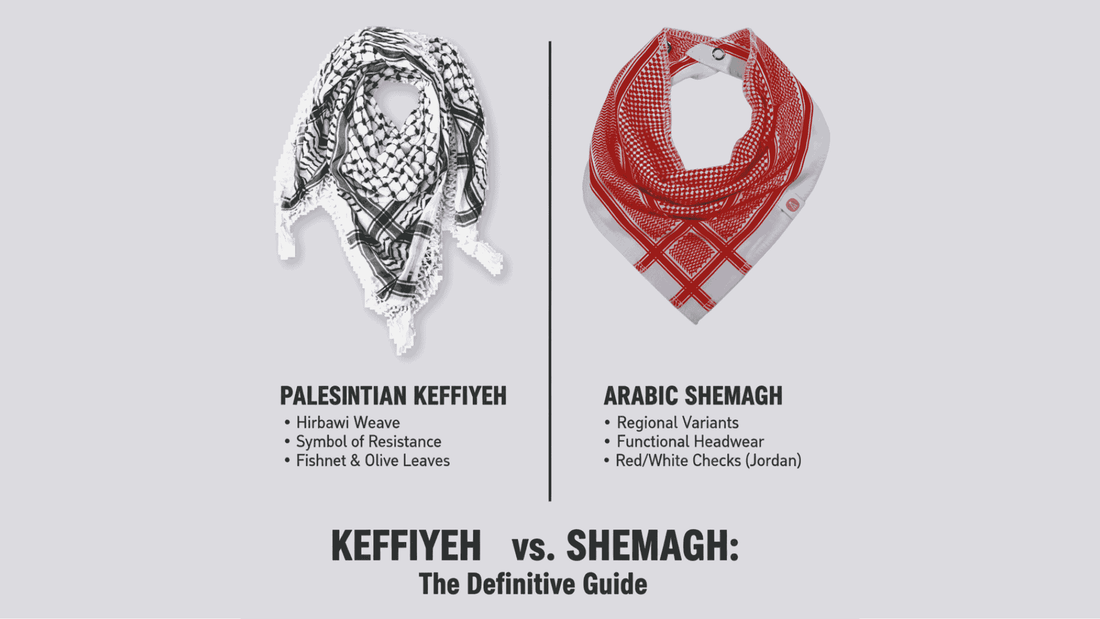
Keffiyeh vs Shemagh: Complete Cultural Guide | Authentic Palestinian Differences
Share

Roots:
For centuries, Arabs living in the Middle Eastern deserts have dressed in ways to survive the living conditions of the desert. Among the most iconic garments are the keffiyeh and shemagh, square scarves made of cotton, wrapped around the head or shoulders to protect against sun, wind, and sand.
On the surface, they seem similar. Both are practical, both are cultural, and both have crossed into global fashion. Yet, the difference between a Palestinian keffiyeh and an Arabic shemagh lies in history, symbolism, and identity.
1. Manufacturing Differences: Hirbawi vs. Mass Production
One of the clearest distinctions isn't in the shape, it's in the craftsmanship.
The Palestinian Keffiyeh, particularly manufactured by the Hirbawi:
The Hirbawi factory in Hebron is the last remaining producer of authentic Palestinian keffiyehs. Founded in 1961 by Yasser Hirbawi, it has survived decades of political and economic pressure, including cheap mass-produced imitations flooding the global market. Yet, Hirbawi remains committed to traditional weaving methods, using high-quality cotton and time-honored designs like the iconic black-and-white checkered keffiyeh. Each scarf is woven on traditional looms, using high-quality cotton that's light, breathable, and designed for the desert climate. Owning one isn't just about style, it's about preserving Palestinian heritage.
The Shemagh (Regional Variants):
Today, most shemaghs are factory-made across the Middle East and South Asia. They're often thicker, sometimes blended with wool, and produced at scale for military, outdoor, and casual use. They serve a purpose but usually don't carry the same cultural weight.
In other words: All keffiyehs can be seen as a type of shemagh, but not all shemaghs are keffiyehs.
2. Cultural Contexts and Appropriate Usage
The Palestinian keffiyeh, especially the black-and-white design, goes far beyond practicality. It became a symbol of Palestinian identity, resistance, and solidarity during the 20th century, adopted worldwide as a sign of cultural pride.
The shemagh, on the other hand, has broader Arab associations.
- In Jordan, the red-and-white shemagh (kufiya or shemagh mhadab) is tied to Hashemite tradition.
- In the Gulf, the plain white version (ghutrah) is a daily staple and symbol of elegance.
- Militaries around the world have also adopted the shemagh for its practicality in rugged environments.
3. Patterns and Symbolism
The most striking keffiyeh difference lies in the symbolism woven into its design:
Palestinian Keffiyeh Patterns:
- Fishnet motif → ties to Palestinian fishermen and the Mediterranean.
- Olive leaves → resilience and connection to the land, symbolizing Palestinian olive trees.
- Bold lines → ancient trade routes across Palestine.

Arabic Shemagh Patterns:
- Red and white checks → popular in Jordan and parts of Saudi Arabia.

- Plain white → common in Gulf states, often worn with the agal (black cord).

- Military variations → simplified or camouflage versions for tactical use.

This is why people often ask: "Palestinian keffiyeh vs Arabic shemagh; what's the difference?" The answer is that the Palestinian version carries cultural storytelling, while the shemagh is more functional or regional. The Palestinian Keffiyeh, inherited across different generations, carries a long-lived story of Palestinian resilience and resistance to oppression. It now carries the culture, heritage and resilience that the Palestinians are known for. It symbolizes the pursuit of freedom and liberation on the land of Palestine. International icons such as Nelson Mandela and Fidel Castro later embraced it as a universal emblem of anti-imperialism, linking struggles for justice across continents. Today, wearing a keffiyeh signifies solidarity with the Palestinian cause, making it a powerful global symbol in demonstrations, universities, and even popular culture.
In recent decades, the keffiyeh has crossed from cultural identity into mainstream fashion, sometimes respectfully, sometimes problematically. Western brands have attempted to market it as a "trend accessory," often stripping away its historical meaning. For Palestinians, however, the scarf is never just a trend. It is a piece of identity that cannot be divorced from its roots. Choosing an authentic keffiyeh, especially one woven at the Hirbawi factory, is more than a fashion choice: it is a way to honor a living culture and resist cultural erasure.
Frequently Asked Questions
What is the difference between a keffiyeh and a shemagh?
All keffiyehs can be seen as a type of shemagh, but not all shemaghs are keffiyehs. The Palestinian keffiyeh carries specific cultural symbolism and is traditionally made at the Hirbawi factory in Hebron, representing Palestinian identity and heritage.
What makes Hirbawi keffiyehs authentic?
Hirbawi keffiyehs are woven on traditional looms in Hebron, Palestine, using high-quality cotton and time-honored techniques. The Hirbawi factory, founded in 1961, is the last remaining Palestinian keffiyeh manufacturer, making each piece a genuine connection to Palestinian craftsmanship.
What do the patterns on a Palestinian keffiyeh mean?
Palestinian keffiyeh patterns carry deep symbolism: the fishnet motif represents Palestinian fishermen and the Mediterranean, olive leaves symbolize resilience and connection to the land, and bold lines represent ancient trade routes across Palestine.